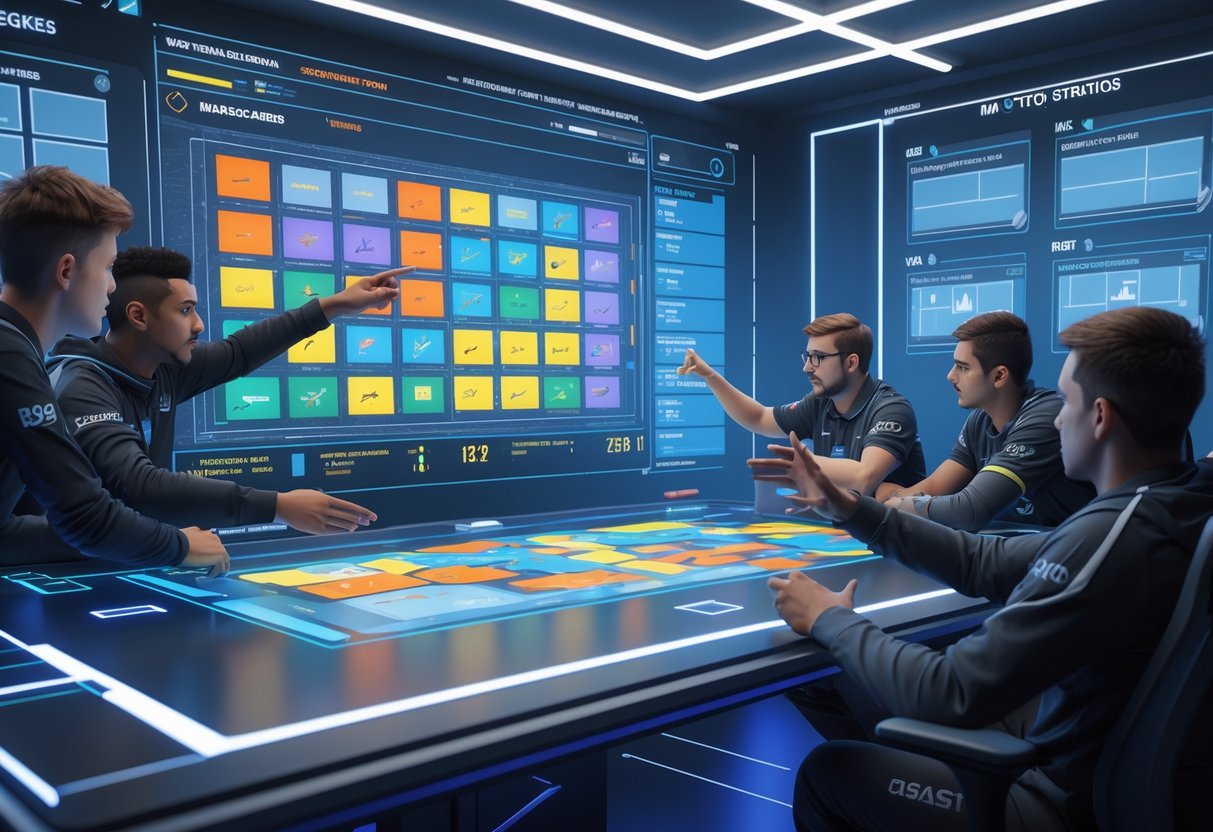Map Veto Strategies: Winning Tactics for CS2 and CSGO
Updated On: October 26, 2025 by Aaron Connolly
Map Veto Strategies Explained
The veto process decides which battleground your team will fight on. It’s honestly one of the most important strategic moments in CS2.
Knowing when to ban your weakest maps or when to target the other team’s strengths can totally change your odds—sometimes before anyone even loads into the server.
Key Objectives in the Veto Process
Every veto needs a clear plan. You want to balance offense and defense, but it’s not just about getting rid of your worst maps.
The main goal? Create the best matchup possible for your team.
Eliminate opponent strengths first. If the other team wins 80% of their games on a map, ban it. It usually matters more than removing your own 40% win map. Make them play somewhere uncomfortable.
Preserve your best maps. Figure out your top three maps and fight to keep at least one in play. Teams with a strong map identity can really use that to their advantage.
Pay attention to the format. In best-of-one games, you can take more risks with bans. Best-of-threes need a wider map pool and a bit more caution.
Here’s a simple priority list a lot of teams follow:
- First ban: Opponent’s best map, statistically
- Second ban: Your weakest map (if it’s still available)
- Pick phase: Grab your strongest map that’s left
- Final bans: Remove any comfort picks the other team has left
Balancing Team Strengths and Weaknesses
Be brutally honest about your team’s map skills. Track your performance data and look for patterns in play style.
Build a team map matrix. List every active map and rate your team from 1 to 5. Think about aim duels, utility, site executes—whatever matters most to you. Most teams find they’re really only competitive on about 4-5 maps.
Know your tactical identity. If your team rushes a lot, you’ll play differently than a squad that loves slow, utility-heavy rounds. Mirage is great for aimers, while Inferno is more for teams who coordinate executes.
Factor in individual player strengths. If your AWPer hates close-quarters maps, remember that during vetoes. Got strong riflers? Maybe you want more aim-heavy maps.
Quick win: Check your last 10 games on each map. If you’re under 30% win rate, just ban it—unless your opponent is somehow even worse.
Types of Map Vetoes
Teams usually pick from three main veto styles, depending on the situation and their strengths.
Comfort-based vetoes keep you on familiar ground. Ban your worst maps, aim for something you’ve practiced. This works for newer teams or those still building their map pool.
Counter-strategic vetoes go after what the other team loves. You might give up a bit of comfort to deny their best maps. Pros use this a lot when facing one-trick teams.
Meta-based vetoes look at what’s hot right now. If a recent patch changed a map, maybe you skip it—even if you were good on it before.
| Veto Type | When to Use | Risk Level | Best For |
|---|---|---|---|
| Comfort-based | Against unknown opponents | Low | New teams |
| Counter-strategic | Against specialists | Medium | Experienced teams |
| Meta-based | After major updates | High | Pro-level teams |
Heads up: Don’t overcomplicate vetoes in lower-level games. Most of the time, your own prep matters more than some deep analysis of the other team—at least until you’re playing at a pretty high level.
Understanding Map Veto Formats
Different competitive formats use their own veto systems. The format you play in changes how you prep, how deep your strategy goes, and sometimes even the pace of the match.
Best-of-One Versus Best-of-Three
Best-of-one matches keep things simple. Teams take turns banning maps until only one is left.
You’ll see this in group stages and qualifiers. Teams have to be ready for anything, since there’s no chance to adapt mid-series.
Usually, the order is: Team A bans, Team B bans, and so on until one map remains. Sometimes there’s a coin toss or a set pick order to decide who bans first.
Best-of-three matches add more strategy. You play up to three maps, and the first to win two takes the match.
The process goes like this:
- Each team bans a map
- Each team picks a map they want to play
- Both teams ban again
- The last map left is the decider if needed
Teams can show their best maps early or save them for the end. This format rewards teams who can play more maps and adapt on the fly.
Sequential Vetoing
Sequential vetoing follows a strict turn order. The sequence is set before the match.
Teams don’t get to pause or discuss once it starts. Every choice matters because there’s no second chance.
Typical sequence:
- Team A bans one map
- Team B bans one map
- Team A picks a map
- Team B picks a map
- Teams alternate bans
- The last map or maps are left for play
Organisers publish these orders in advance. Smart teams study them ahead of time and plan their priorities.
The predictability helps teams stick to a plan, but it also lets opponents guess what you’ll do if they know your habits.
Randomised and Opponent-Driven Formats
Some tournaments mix things up with random draws. Maybe a random pick decides which team bans first, or which maps start in the pool.
This stops teams from over-prepping for one scenario. It also means you’ll see more map variety across matches.
Opponent-driven formats let teams influence what their rivals play. For example, after a ban, Team A might pick which map Team B has to choose from.
That adds some mind games to the veto phase. You have to think about what hurts the other team most—not just what helps you.
Draft-style formats let both teams build the map pool together. Each team adds a map, then both sides cut options down.
These show up in smaller events or show matches, not usually in big tournaments.
Analysing Opponent Map Preferences

If you know your opponent’s map strengths and weaknesses, you’ll have a big edge in the veto phase. Dig into their past games, spot patterns, and use pro match data to make smarter calls.
Gathering Data on Enemy Map History
Check out your opponent’s recent matches on every map. Focus on their win rates over the last 20-30 games.
Key things to track:
- Win percentage for each map
- Average round difference (are games close or blowouts?)
- Recent performance trends (last two weeks)
- How individual players do on each map
Most teams have 2-3 maps where they’re strong and 1-2 where they just can’t win. Target maps where they’re under 40% win rate or lose badly.
Look at how they do against teams at your level. Sometimes a team crushes weaker squads on Dust2 but falls apart against equals.
Heads up: Don’t use old data—anything past two months is risky. Teams change fast.
Pattern Recognition in Map Choices
Watch for habits in vetoes. Teams tend to stick to what they know.
Look for these signs:
- Always banning the same 1-2 maps
- Picking comfort maps early in tournaments
- Avoiding aim-heavy maps if their fraggers are weak
- Going for tactical maps if they have a strong in-game leader
Track their first ban across several matches. Teams usually get rid of their worst map right away. That tells you what they really don’t want to play.
See if they change up their strategy in big matches. Some teams play it safe when it matters, but experiment when the stakes are lower.
Keep notes on how they pick maps against different styles. Maybe they dodge certain maps against aggressive teams but pick them versus passive ones.
Utilising Pro Match Resources
Pro match databases offer more than just scores. You can find everything from economy stats to site preferences.
Useful resources:
- HLTV.org – Full match history and detailed stats
- Liquipedia – Tournament results and team info
- FACEIT/ESEA – Practice matches and league games
Don’t just check win/loss. Look at round breakdowns to see if a team struggles on CT or T side of certain maps.
Analysts on broadcasts often point out team weaknesses. Save those clips or jot down notes if someone mentions your next opponent.
Quick tip: Set alerts for your opponent’s games so you can watch them live. You might catch new tactics before they hit the stats sites.
If demo files are out there, watch full matches. You’ll see rotation patterns, default setups, and how they react under pressure—stuff stats just can’t show.
Developing Your Team’s Map Pool

Building a strong map pool means figuring out your best maps and making sure you can hold your own on enough maps to avoid easy bans. The trick is balancing deep knowledge of your top maps with enough flexibility to avoid being predictable.
Identifying Core Maps
Pick 2-3 maps where your team always feels solid. These will be your go-to choices in big games.
Start by checking your match history. Look at win rates, round differences, and ask your players how comfortable they feel on each map.
Look at these things:
- Player strengths and favorite spots
- Team communication and coordination
- Clutch success rates
- How well you adapt mid-round
Think about your playstyle when picking core maps. Aggressive teams often shine on Mirage or Cache. Tactical teams might lean toward Inferno or Overpass.
Quick tip: Choose maps that fit your in-game leader’s style. If they’re good at reading the round, pick maps with lots of rotation options.
Training for Flexibility
If you only have 2-3 strong maps, you’re easy to veto. Opponents will just ban your best and force you onto something rough.
Aim to get solid on at least five active maps. That way, you’re not boxed in.
Try a simple practice schedule:
- Monday/Wednesday: Deep dive on core maps
- Tuesday/Thursday: Work on secondary maps
- Friday: Focus on your weakest map
Learn the usual angles, smoke lineups, and basic strats for each map. Don’t try to master everything at once.
Heads up: Don’t spread yourself too thin. It’s better to be good on five maps than average on all seven.
Tracking Team Performance
Keep a record of how your team does on every map. This helps you make smarter veto decisions and spot what needs work.
Track things like:
| Metric | What to Record |
|---|---|
| Win Rate | Overall and recent trends |
| T-Side Rounds | Average rounds as T |
| CT-Side Rounds | Average rounds as CT |
| Pistol Success |
Adapting to Meta and Trends

The CS2 scene changes fast. Teams come up with new strats and map updates can totally shift how the game plays.
Monitoring Professional Scene Changes
Let’s keep an eye on what pro teams are up to with their veto choices. Big tournaments like ESL Pro League and BLAST Premier usually tip us off about which maps are trending.
Pro teams drop maps fast when other squads figure out strong counters. Say a team nails down those Mirage smoke executes—suddenly, everyone else starts banning Mirage more often.
Key things to watch:
- Tournament pick/ban stats
- Recent pro match results for each map
- Notable strategy shifts from top teams
It’s smart to follow pro analysts on social media. They tend to leak emerging trends before everyone else catches on.
Quick win: Check out the latest Major tournament vetoes to spot current pro map preferences.
Semi-pro teams often pick up pro strategies within just a few weeks. So, amateur teams end up facing those same tactics pretty quickly.
Incorporating Latest Map Updates
Valve pushes out map updates that shake up the competitive scene. These changes hit angles, boost spots, and even how players move around the map.
We need to jump into updated maps right after patches drop. Stuff like new wall-bang spots or missing cover can flip map control on its head.
Watch for these update impacts:
- Changed smoke lineups
- New or missing boost spots
- Lighting tweaks that mess with visibility
- Adjusted timings for rotations
Teams usually dodge freshly updated maps for a bit. Everyone needs time to learn new angles and work out counters.
Heads up: Don’t rush to ban updated maps if your opponents haven’t practiced them either.
Set aside practice time for map changes. Spend at least two hours checking new angles and smoke positions after every update.
Major updates can tilt things toward CT or T sides. That shift might change which maps we want to pick or ban, depending on our team’s strengths.
Psychological Tactics in Map Vetoes
Map vetoes aren’t just about picking what you’re good at. They’re about getting in your opponent’s head and making them second-guess their choices with some well-placed psychological pressure.
Mind Games During the Veto
The veto phase naturally creates tension, and we can use that. Teams show their mental state through body language, how they talk, and how fast they ban maps.
Pay attention to how quickly teams ban their first map. Fast bans usually mean they’ve prepped a lot. Slow bans? Maybe they’re not so sure, or they’re arguing.
Apply time pressure by making your bans fast and confident. This puts your opponents on the back foot.
If you can, listen to their comms. Teams that argue during vetoes probably don’t have strong leadership. Go after their comfort picks right away to exploit that.
Try using silence. When your team stays calm and quiet, it looks like you’re super prepared. That can mess with the other team’s confidence.
Some teams even fake strategy talks out loud during warmup. They want the other side to overhear their “favorite maps” and then do the opposite.
Building Confidence and Pressure
Confidence in vetoes carries over into the match. How your team acts here sets the mood for the whole game.
Look certain even if you’re not. If you hesitate, opponents pick up on it and sense weakness.
Ban maps your opponents expect you to pick. That move sows doubt and forces them to rethink their plan.
Try making eye contact with the other team when you ban something important. It’s subtle, but it can actually impact their decisions.
React positively when opponents ban maps you wanted to avoid. Make them wonder if they just did you a favor.
Practice your veto routine ahead of time. Teams that stumble through menus or debate obvious choices look unprepared.
Bluffing and False Preferences
Bluffs in vetoes only work if you keep them believable. Obvious fakes get called out by experienced teams.
Start planting seeds early by talking up certain maps in interviews or on social media. Opponents often dig through your public comments.
Ban your actual strong map first if you think the other team expects you to save it. Sometimes reverse psychology gets you the maps you really want.
Grind your weaker maps in practice before tournaments. If opponents see you playing them, they might waste a ban on those maps thinking they’re your new favorites.
Use stats as a smokescreen. If your recent matches show poor results on a map you’ve secretly improved, that map might slip through.
Fake your reactions when opponents ban maps. Look upset if they ban something you wanted banned anyway.
The best mind games just feel natural. Forced tricks usually flop, especially against teams who’ve seen it all.
Countering Opponent Veto Strategies

Top teams don’t just plan their own vetoes—they try to predict and counter what the other side will do. It pays to study enemy patterns and always have backup plans in case your favorite maps get banned.
Predicting Enemy Bans
Most teams fall into predictable veto patterns based on how they play and their recent results. We can take advantage of that by tracking their past matches and seeing which maps they always ban first.
Patterns to watch:
- Maps they always ban (usually 2-3 per team)
- Their favorite starting side on the maps left over
- Practice footage from streams
- Map stats from the last month
Pro teams usually have signature maps they never want to play. If a team can’t handle Mirage rotations, they’ll ban it every time.
Set up a basic tracking sheet: opponent name, tournament, maps banned first, maps picked, and win/loss. You’ll spot their comfort zones fast.
Heads up: Sometimes teams fake their preferences in throwaway matches to hide real strats for the big events.
Disrupting Expected Picks
Once you know their patterns, you can mess with them by banning comfort picks before they expect it.
Ways to disrupt:
- Ban their second-favorite map, not their strongest
- Force them to pick between two maps they dislike
- Save your worst map ban for last to keep them guessing
- Pick maps where their results are shaky
Picture this: if the other team always expects us to ban Dust2 first, we could ban their backup comfort map instead. Now they either waste a ban on Dust2 or risk playing us on it.
The trick is to make them pick between bad options, not just wipe out our strengths.
Most teams have at least one player who dislikes certain maps. Target those in your veto to exploit individual weak spots.
Contingency Planning
No veto strategy works forever, so you need backup plans. Teams will adapt to your patterns.
Always have:
- Three different veto orders for each opponent type
- Plans for maps you rarely play
- Fast callouts for surprise picks
- Alternate ban priorities if opponents mix things up
Quick win: Practice at least one surprise map pick that doesn’t fit your usual playstyle.
Gaming expert James Connolly calls these “pocket strategies”—simple setups for maps you don’t usually play but can pull out if needed.
Stay flexible with your final picks during vetoes. If the other team does something unexpected, have backup options ready so you don’t panic.
Teams that get good at contingency planning win more often because they’re never totally caught off guard.
Effective Communication During Vetoes

Good vetoes start with honest team talks before the match. You also need someone to take charge when time’s running out.
Essential Pre-Veto Discussions
Talk about map preferences as a team well before the match. This way, everyone can share their thoughts without the pressure of a timer.
List out each player’s best maps. Ask which maps teammates feel comfortable on, and which ones they’d rather avoid.
Build a preference list:
- Top 3 maps your team feels strongest on
- 2-3 maps you want to ban first
- Backup picks if your favorites get vetoed
Scout your opponents too. Look up their recent matches to see what maps they’re winning. Community sites and match databases are handy for this.
Share your research with the whole team. Sometimes one person spots something about the enemy’s playstyle that others miss.
Quick win: Use a shared doc where everyone can drop notes about different maps before the match.
Assigning Veto Responsibilities
Pick one person to call the shots during vetoes. This stops confusion when the clock’s ticking.
The team leader or most experienced player usually handles it. They’ll listen to input but make the final call fast.
Keep it simple:
- Main caller announces each pick or ban
- Other players can suggest ideas in voice chat
- No arguing during vetoes
Practice this setup in scrims or casual matches. Some teams even rotate the veto leader so everyone gets a turn.
Heads up: Don’t let multiple people input bans at once. That just creates chaos and wastes time.
The veto leader should know everyone’s map preferences by heart. Jot them down if you have to, but memorizing them is better under pressure.
Utilising Data and Analytics for Veto Decisions

Digging into data changes how teams handle map vetoes. Instead of guessing, we can make evidence-based choices. Stats tools and visual analytics help teams spot patterns and make smarter calls under pressure.
Leveraging Statistics Tools
We can use match history sites and analytics platforms to guide our vetoes. HLTV.org (for CS2) and Liquipedia track team map performance with detailed stats.
Look at these numbers:
- Win rates on each map in recent matches
- Results against similar team styles
- Trends and momentum shifts
Teams often forget head-to-head stats when making veto calls. Maybe your team does well on Inferno against most, but not against teams that play super aggressive T-side.
Pros recommend checking at least 10-15 recent matches to spot patterns. Quick win: Focus on matches from the last month, since teams change fast.
Free tools like Leetify give you basic map performance analytics. Premium platforms go deeper, but you don’t need them to get started.
Visualising Veto Outcomes
Heat maps and charts make stats easier to digest when you’re on the clock. Build simple spreadsheets or use tools like Tableau to see your team’s strengths and weaknesses.
Handy visualisation ideas:
- Color-coded win/loss grids for each map
- Performance trend lines over time
- Comparison charts for specific matchups
Smart teams prep veto flowcharts before games, mapping out what to do if certain bans happen. If Team A bans Mirage first, maybe they’re bad at mid control, so you adjust your next ban.
Don’t overdo it: Keep your charts simple for live matches. You only get about 30 seconds to decide.
Some orgs build fancy dashboards, but honestly, basic Excel charts do the trick for most teams without a dedicated analyst.
Common Map Veto Mistakes to Avoid

Teams lose matches before the game even starts because of bad vetoes. If you make poor choices, you might get stuck playing on maps where your opponents have all the advantages.
Not knowing your opponents tops the list of veto mistakes. Some teams just ban maps randomly without checking what the other side likes or hates.
Critical Veto Errors
| Mistake | Why It’s Costly | Quick Fix |
|---|---|---|
| Banning your best map first | Wastes your strongest advantage | Always force opponents to ban it |
| Ignoring team comfort picks | Creates unnecessary pressure | Prioritise maps you’ve practised |
| Following outdated strategies | Meta changes constantly | Review recent opponent matches |
Failing to consider your team’s strengths ruins so many veto phases. It’s wild how often players pick maps they’ve barely touched in practice.
Maybe your team dominates Dust2 but falls apart on Mirage. Don’t let pride get in the way of a smart call.
Warning: Don’t veto just because you like or dislike a map. Your favorite could be the team’s weak spot.
Poor communication during vetos causes chaos fast. Pick one person to make the final call while everyone else gives input quickly.
Some teams panic and rush bans. Use all the time you’re given to talk things out.
Overthinking the process can trip you up. Sometimes the obvious pick really is the right one.
Building Confidence in Your Choices
We make better veto calls when we trust our prep and stick with what’s worked before. Confidence comes from having solid info about where we shine and where our opponents fall short.
Start with what you know works. Check your win rates for each map over the past month. If we’re winning 70% on Inferno but only 45% on Mirage, that’s a clue.
Practice different veto scenarios before match day. Run through possible ban orders together so everyone’s on the same page.
| Confidence Builder | Quick Action |
|---|---|
| Know your stats | Check recent win/loss per map |
| Study opponents | Review their last 5 matches |
| Have backup plans | Prepare for 3 different veto orders |
Write down your reasoning for every veto choice. Jot down why you banned Ancient or picked Dust2. This helps you learn from both wins and mistakes.
Don’t second-guess yourself in the middle of vetoes. Teams that flip-flop mid-process usually end up on maps they barely know.
Quick win: Make a simple spreadsheet to track your team’s map results. Update it each week to spot trends and boost your confidence.
Trust your prep over gut feelings. We’ve all seen teams get burned by emotional vetoes. Stick to your strengths and the data.
Even the pros lose on their best maps sometimes. One bad game doesn’t mean your entire veto plan is off.
Refining Map Veto Strategies Over Time

Map veto strategies never stay the same. You’ve got to keep updating them as your team changes and the scene shifts.
Track your performance after every match to spot what’s working. Note which maps you picked and how things went.
Keep a basic record of your veto calls:
| Match Date | Maps Banned | Maps Picked | Result | Notes |
|---|---|---|---|---|
| 15/08/2025 | Mirage, Dust2 | Inferno | Win 16-12 | Strong T-side |
| 18/08/2025 | Ancient, Nuke | Cache | Loss 13-16 | Weak rotations |
Review opponent trends often. Teams swap up their favorite maps as the meta shifts.
Watch how top teams handle their vetoes. Notice which maps they always ban or pick.
Adapt to roster changes right away. New players might love maps your old squad hated.
Practice new maps in scrims before you try them in real matches. Don’t gamble in big games with untested maps.
Update your strategy at least monthly. The CS2 scene changes fast with patches and new plays.
Warning: Don’t overhaul your strategy over one bad match. Look for patterns over several games before making big changes.
Think about seasonal stuff too. Some maps favor defense when teams play more carefully in certain tournaments.
Your veto plan should grow with your team’s skill and confidence.
Frequently Asked Questions

Map vetoes always spark a bunch of questions about timing, reading opponents, and adapting for tournaments. Figuring out how to judge maps, tailor your team’s approach, and adjust for unknown rivals is at the heart of good competitive play.
How can one effectively determine the best map to veto in a competitive match?
We suggest digging into your opponent’s recent matches to see which maps they crush on. Check their win rates for each map over the last month.
Look at the maps they pick or leave open most. Those are probably their comfort picks.
Your team should also think about your own map strengths and weak spots. Ban maps where they’re strong but you’re shaky, not just their top map.
Quick win: Use match history sites to grab opponent stats before vetoes start. It beats guessing.
What are key factors to consider when developing a veto strategy for team-based games?
Team chemistry on certain maps should shape your vetoes. Some maps reward tight teamwork, others let individual stars shine.
Think about your tactical style. If you like to rush, skip maps that favor slow, defensive play.
Roles matter a lot. Maps that need a strong AWP might not fit if you don’t have a dedicated sniper.
Warning: Don’t just copy pro team vetoes. Your squad isn’t them.
How much time you’ve practiced a map makes a difference too. Focus vetoes around what you’ve worked on most lately.
Could you suggest ways to adapt veto strategies when facing an unfamiliar opponent?
If you can’t find info on your opponent, just stick to your team’s best maps. Play to your strengths instead of guessing theirs.
Ban the most mechanically demanding maps if you’re unsure about their skill. That can keep you from getting out-aimed.
Pick maps with lots of strategy options. That way, you can switch things up if your first plan doesn’t work.
Check their old teams or orgs. Players often bring their map preferences with them.
Quick win: Ask around your scene. Someone might have played them and can give you a heads up.
What’s the best approach to map vetoes for balanced gameplay in a tournament setting?
Tournaments need a different veto mindset than single matches. Think about your team’s stamina if you’re playing multiple games in a day.
We’d avoid your most complex maps early on. Save those for elimination rounds when you’ve got extra prep time.
Ban maps that need a long warm-up. Tournaments usually don’t give you much downtime.
Pick maps where comebacks are doable. Under pressure, you want a chance to turn things around.
Don’t forget about mental fatigue. Later rounds are easier if you’re on maps with simple callouts and positions.
Are there any common mistakes to avoid during the map selection and veto process?
Over-thinking vetoes leads to trouble. Stick to what you planned, don’t panic and change last minute.
Warning: Don’t ban maps just because you lost there once. A single loss doesn’t mean you’re bad at it.
Teams often forget what they’ve actually practiced. If you’ve drilled a map for weeks, play it instead of chasing a “smart” pick.
Letting emotions run vetoes after arguments messes up teamwork. Talk about map preferences in practice, not live on stage.
Plenty of teams ban maps they’re actually fine at because they fear better opponents. Sometimes your “average” map is still winnable.
How does one keep up to date with the latest changes in map pools for strategic vetoes?
Game developers usually announce map pool changes through their official channels and patch notes. It’s honestly best to subscribe to these updates directly—third-party sources can be slow or miss details.
Major tournament organizers sometimes tweak map pools before the developers do. If you follow big tournament announcements, you’ll often catch wind of changes before everyone else.
I always recommend tracking community discussions about map balance. Players tend to spot strategic shifts early, sometimes even before the pros catch on.
Quick win: Turn on notifications for your game’s official social media accounts. That way, you won’t miss any critical map updates.
Jump into practicing new maps as soon as they hit rotation. Getting in early gives you a real edge over teams that wait for the meta to settle.
Keep an eye on community workshop maps, too. Sometimes, those popular custom maps end up going official and shake up the competitive scene.

